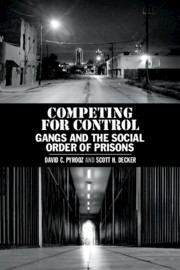Book contents
- Competing for Control
- Competing for Control
- Copyright page
- Contents
- Figures
- Tables
- Acknowledgments
- 1 Foundation for the Study
- 2 Understanding Gangs in Prison
- 3 The LoneStar Project
- 4 The Characteristics of Gang Members in Prison
- 5 The Characteristics of Gangs in Prison
- 6 The Role of Gangs in the Social Order of Prisons
- 7 Misconduct and Victimization in Prison
- 8 Joining and Avoiding Gangs in Prison
- 9 Continuity and Change in Prison Gang Membership
- 10 Implications of Competing for Control
- Appendix Preliminary Evaluation of the Gang Renouncement and Disassociation Program
- References
- Index
4 - The Characteristics of Gang Members in Prison
Published online by Cambridge University Press: 09 August 2019
- Competing for Control
- Competing for Control
- Copyright page
- Contents
- Figures
- Tables
- Acknowledgments
- 1 Foundation for the Study
- 2 Understanding Gangs in Prison
- 3 The LoneStar Project
- 4 The Characteristics of Gang Members in Prison
- 5 The Characteristics of Gangs in Prison
- 6 The Role of Gangs in the Social Order of Prisons
- 7 Misconduct and Victimization in Prison
- 8 Joining and Avoiding Gangs in Prison
- 9 Continuity and Change in Prison Gang Membership
- 10 Implications of Competing for Control
- Appendix Preliminary Evaluation of the Gang Renouncement and Disassociation Program
- References
- Index
Summary
Who are the members of gangs in prison? What attitudes and beliefs do they maintain? What do their social networks look like? And how similar are they to inmates who are not in gangs? In many ways, we see these questions as an extension of Chapter 3 because it provides an additional description of our sample. After all, these are individuals as well as members of a group. We reported in prior chapters that a large majority of prison inmates in the United States are not gang members. In other words, there is a small group of inmates (~15 percent) who affiliate with gangs and a much larger group of inmates who do not. This is also the case in Texas. Both official records and self-reports of prison gang membership confirm this. In this chapter, our objective is to compare gang and non-gang inmates across a range of characteristics.
- Type
- Chapter
- Information
- Competing for ControlGangs and the Social Order of Prisons, pp. 71 - 93Publisher: Cambridge University PressPrint publication year: 2019

